PRINCETON, NJ -- The inaugural results of a new Gallup question -- posed to more than 120,000 U.S. adults thus far -- shows that 3.4% say "yes" when asked if they identify as lesbian, gay, bisexual, or transgender.
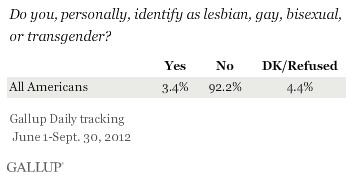
These results are based on responses to the question, "Do you, personally, identify as lesbian, gay, bisexual, or transgender?" included in 121,290 Gallup Daily tracking interviews conducted between June 1 and Sept. 30, 2012. This is the largest single study of the distribution of the lesbian, gay, bisexual, and transgender (LGBT) population in the U.S. on record. By comparison, the General Social Survey, a project of NORC at the University of Chicago, asked a sexual orientation question in its 2008 and 2010 survey of about 2,000 adults in each year. The U.S. Department of Health and Human Services' National Survey of Family Growth asked a sexual orientation question of about 12,000 young adults aged 18 to 44 in 2002 and of more than 20,000 adults in its 2006-2010 survey. The 3.4% figure is similar to a 3.8% estimate made by one of the authors of this study (Gates), averaging a group of smaller U.S. surveys conducted from 2004 to 2008.
Exactly who makes up the LGBT community and how this group should be measured is a subject of some debate. Measuring sexual orientation and gender identity can be challenging since these concepts involve complex social and cultural patterns. As a group still subject to social stigma, many of those who identify as lesbian, gay, bisexual, or transgender may not be forthcoming about this identity when asked about it in a survey. Therefore, it's likely that some Americans in what is commonly referred to as "the closet" would not be included in the estimates derived from the Gallup interviews. Thus, the 3.4% estimate can best be represented as adult Americans who publicly identify themselves as part of the LGBT community when asked in a survey context.
There are a number of ways to measure lesbian, gay, and bisexual orientation, and transgender status. Sexual orientation can be assessed by measuring identity as well as sexual behaviors and attractions. Transgender status can be an identity but can also include consideration of behaviors regarding gender nonconformity and an individual's internal sense of gender.
Gallup chose the broad measure of personal identification as LGBT because this grouping of four statuses is commonly used in current American discourse, and as a result has important cultural and political significance. One obvious limitation of this approach is that it is not possible to separately consider differences among lesbians, gay men, bisexuals, or transgender individuals. A second limitation is that this approach measures broad self-identity, and does not measure sexual or other behavior, either past or present.
The following sections review the percentage identifying as LGBT across specific subgroups of the U.S. population. Overall, the results from this analysis run counter to some media stereotypes that portray the LGBT community as predominantly white, highly educated, and very wealthy.
Nonwhite Individuals More Likely to Identify as LGBT
Nonwhites are more likely than white segments of the U.S. population to identify as LGBT. The survey results show that 4.6% of African-Americans identify as LGBT, along with 4.0% of Hispanics and 4.3% of Asians. The disproportionately higher representation of LGBT status among nonwhite population segments corresponds to the slightly below-average 3.2% of white Americans who identified as LGBT.
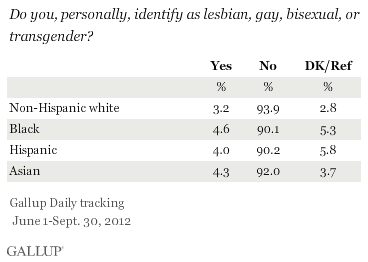
Overall, a third of LGBT-identifiers are nonwhite (33%), compared with 27% of non-LGBT individuals.
Women Are More Likely to Identify as LGBT Than Are Men
Although the difference is not large, women are slightly more likely to identify as LGBT than are men (3.6% vs. 3.3%) -- a finding that is consistent with other surveys. Put differently, more than 53% of LGBT individuals are women.
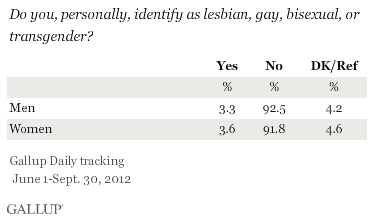
Younger Americans More Likely to Identify as LGBT
Adults aged 18 to 29 (6.4%) are more than three times as likely as seniors aged 65 and older (1.9%) to identify as LGBT. Among those aged 30 to 64, LGBT identity declines with age -- at 3.2% for 30- to 49-year-olds and 2.6% for 50- to 64-year-olds.
Consistent with other recent studies and with the gender gap identified earlier in this report, younger women are more likely to identify as LGBT than are younger men. Among 18- to 29-year-olds, 8.3% of women identify as LGBT, compared with 4.6% of men the same age.

It is possible that some of these age differences are due to a greater reluctance on the part of older Americans who may be LGBT to identify as such. In general, younger Americans are more accepting of equal rights and opportunities for gay men and lesbians.
LGBT Americans Tend to Have Lower Levels of Education and Income
Gallup's analysis shows that identification as LGBT is highest among Americans with the lowest levels of education -- contrary to what other, more limited, studies have shown. Among those with a high school education or less, 3.5% identify as LGBT, compared with 2.8% of those with a college degree and 3.2% of those with postgraduate education. LGBT identification is highest among those with some college education but not a college degree, at 4.0%.

A similar pattern is found across income groups. More than 5% of those with incomes of less than $24,000 a year identify as LGBT, a higher proportion than among those with higher incomes -- including 2.8% of those making $60,000 a year or more.

Among those who report income, about 16% of LGBT-identified individuals have incomes above $90,000 per year, compared with 21% of the overall adult population. Additionally, 35% of those who identify as LGBT report incomes of less than $24,000 a year, significantly higher than the 24% for the population in general. These findings are consistent with research showing that LGBT people are at a higher risk of poverty.
These data also explain why LGBT Americans are less satisfied with their standard of living than non-LGBT Americans. Nearly three-quarters of non-LGBT individuals (73%) say they are satisfied with their standard of living, compared with less than two-thirds (65%) of LGBT individuals.
While LGBT men and women may not be as happy with their current economic situation, they are more optimistic than their non-LGBT counterparts about the future. Nearly 59% of LGBT individuals say their standard of living is getting better, compared with less than half (49%) of non-LGBT men and women.
Those in Domestic Partnerships, or Never-Married Singles More Likely to Be LGBT
Nearly 13% of individuals in a domestic partnership or living with a partner identify as LGBT, making this one of the highest representations of LGBT status of any subgroup analyzed. Seven percent of single, never-married individuals identify as LGBT. The percentage of LGBT individuals among those who are currently married is lowest of any marital status group, at 1.3%.
The Gallup survey does not include questions asking about the gender of spouses or partners, so it is possible that some married LGBT people have same-sex spouses and is certainly more likely that some percentage of those in domestic partnerships could have a same-sex partner. It's also possible that bisexual individuals are married or living with a different-sex partner.
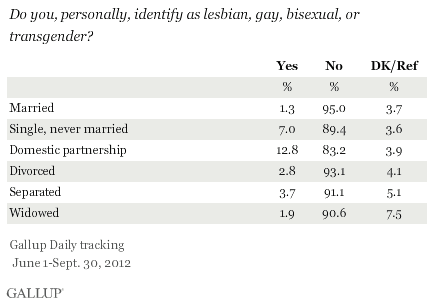
In total, 20% of LGBT individuals indicate that they are married and an additional 18% are in a domestic partnership or living with a partner. Nearly half (48%) are single and have never married. Among non-LGBT Americans, 54% are married, 4% are living with a partner, and 23% are single and have never married.
LGBT Women as Likely as Non-LGBT Women to Be Raising Children
LGBT identification is lower among Americans with children under age 18 in their home (2.7%) than it is among those with no children younger than 18 in the home (3.9%). But this difference is largely due to fewer LGBT men reporting they have children in the home. Among women with children, 3.6% identify as LGBT (the same as the 3.6% among women not raising children). But among men with children, 1.8% identify as LGBT, compared with 4.2% of men who do not have children under 18 in the home.
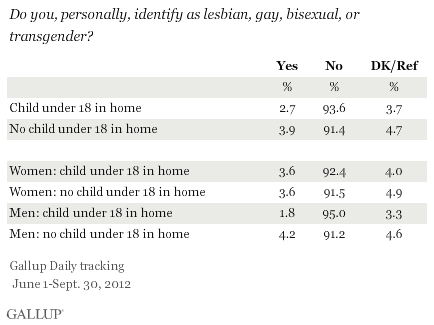
Looked at differently, the results show that about 32% of both non-LGBT women and LGBT women have children under 18 in the home. By contrast, there is a large difference in child status across the two groups of men, with LGBT men about half as likely as other men to have children in the home -- 16% vs. 31%, respectively.
Prior research suggests that within the LGBT population, child-rearing is much more common among racial and ethnic minorities, a finding that is substantiated by the current data. More than 41% of Hispanic and African-American LGBT women, along with 38% of Asian LGBT women, are raising children, compared with 28% of white LGBT women. Some of this reflects the younger average ages of racial and ethnic groups in the U.S.
Ten percent of LGBT white men are raising children, compared with 39% of Hispanic men, 31% of Asian men, and 14% of African-American men. Non-LGBT men are more likely to have children: 29% among whites, 34% of African-Americans, 44% of Hispanics, and 35% of Asians.
East and West Regions Are Home to More LGBT Identifiers
LGBT identification is slightly higher in the East (3.7%) and the West (3.6%) than in the Midwest (3.4%) and the South (3.2%). This slightly higher incidence on both coasts could be a product of two factors. More accepting regions may attract LGBT people to move there. But it may also be the case that social acceptance in the East and West means that LGBT people are more willing to self-identify, because they feel less stigmatized by their identity.
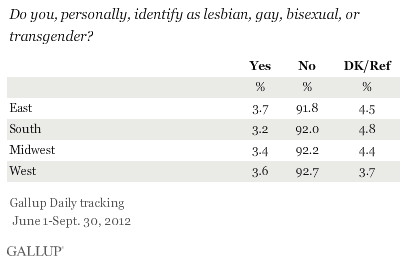
Implications
This report marks the first step in analyzing the largest population-based survey of LGBT Americans ever conducted. Upcoming reports on Gallup.com will analyze LGBT political attitudes and perspectives, and review the impact of self-reported LGBT identity on health and well-being. Gallup will continue to include the LGBT question in its Daily tracking survey, which will provide the ability to analyze trends and correlates of LGBT status in the U.S. across a wide variety of social, cultural, economic, and political indicators.
This initial analysis reveals new insights into the composition of the LGBT community in the U.S. In particular, the findings challenge both media and cultural stereotypes to reveal that the LGBT population is in a number of ways not that different from the broader U.S. population.
As courts, legislatures, and voters continue to debate issues like marriage for same-sex couples, child-rearing rights for LGBT people, and bans on workplace discrimination based on sexual orientation and gender identity, these data provide new and detailed information about the lives of LGBT Americans and their families. They offer an unprecedented resource for informing those debates with facts rather than stereotype or anecdote.
Gary J. Gates is the Williams Distinguished Scholar at the Williams Institute, UCLA School of Law. A national expert in LGBT demographics, he holds a PhD in Public Policy from the Heinz College, Carnegie Mellon University.
Survey Methods
Results are based on telephone interviews conducted as part of the Gallup Daily tracking survey June 1-Sept. 30, 2012, with a random sample of 121,290 adults, aged 18 and older, living in all 50 U.S. states and the District of Columbia, selected using random-digit-dial sampling.
For results based on the total sample of [national adults/registered voters], one can say with 95% confidence that the maximum margin of sampling error is <±1 percentage point.
Interviews are conducted with respondents on landline telephones and cellular phones, with interviews conducted in Spanish for respondents who are primarily Spanish-speaking. Each sample includes a minimum quota of 400 cell phone respondents and 600 landline respondents per 1,000 national adults, with additional minimum quotas among landline respondents by region. Landline telephone numbers are chosen at random among listed telephone numbers. Cell phone numbers are selected using random-digit-dial methods. Landline respondents are chosen at random within each household on the basis of which member had the most recent birthday.
Samples are weighted by gender, age, race, Hispanic ethnicity, education, region, adults in the household, and phone status (cell phone only/landline only/both, cell phone mostly, and having an unlisted landline number). Demographic weighting targets are based on the March 2011 Current Population Survey figures for the aged 18 and older non-institutionalized population living in U.S. telephone households. All reported margins of sampling error include the computed design effects for weighting and sample design.
In addition to sampling error, question wording and practical difficulties in conducting surveys can introduce error or bias into the findings of public opinion polls.
For more details on Gallup's polling methodology, visit www.gallup.com.
